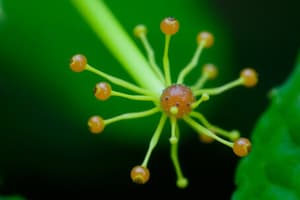Podcast
Questions and Answers
What was the significance of Robert Hooke's observations under the microscope?
What was the significance of Robert Hooke's observations under the microscope?
- He discovered living cells in animal tissues.
- He coined the term 'cells' after observing cork. (correct)
- He disproved the theory of spontaneous generation.
- He created the first practical microscope.
Which scientist is credited with the discovery of 'Animalcules'?
Which scientist is credited with the discovery of 'Animalcules'?
- Felix Dujardin
- Robert Hooke
- Anton van Leeuwenhoek (correct)
- Louis Pasteur
What is the primary function of the microscope in biology?
What is the primary function of the microscope in biology?
- To enhance the visibility of small structures. (correct)
- To measure the weight of specimens.
- To observe the chemical properties of cells.
- To classify living organisms.
What major theory did Louis Pasteur help to disprove through his experiments?
What major theory did Louis Pasteur help to disprove through his experiments?
What did Felix Dujardin discover when studying cells?
What did Felix Dujardin discover when studying cells?
How does studying biology enhance our understanding of living organisms?
How does studying biology enhance our understanding of living organisms?
Which part of the microscope is primarily responsible for magnification?
Which part of the microscope is primarily responsible for magnification?
What is the main difference between prokaryotic and eukaryotic cells in terms of structure?
What is the main difference between prokaryotic and eukaryotic cells in terms of structure?
What is the primary purpose of the iris diaphragm in a microscope?
What is the primary purpose of the iris diaphragm in a microscope?
Which part of the microscope is directly responsible for focusing an object when using low power objectives?
Which part of the microscope is directly responsible for focusing an object when using low power objectives?
What is the primary function of methylene blue in cell staining?
What is the primary function of methylene blue in cell staining?
Which objective lens provides the highest magnification on a microscope?
Which objective lens provides the highest magnification on a microscope?
What role does the base of a microscope serve?
What role does the base of a microscope serve?
What are the main components of the cell theory?
What are the main components of the cell theory?
Which part of a compound light microscope is responsible for gathering light and illuminating the specimen?
Which part of a compound light microscope is responsible for gathering light and illuminating the specimen?
Who is considered a pioneer in the development of early microscopy?
Who is considered a pioneer in the development of early microscopy?
How does microscopy contribute to the study of biology?
How does microscopy contribute to the study of biology?
Which of the following characteristics is NOT a basic feature of living things?
Which of the following characteristics is NOT a basic feature of living things?
Which structure in a cell is primarily responsible for energy transformation?
Which structure in a cell is primarily responsible for energy transformation?
What is the primary purpose of the eyepiece lens in a compound light microscope?
What is the primary purpose of the eyepiece lens in a compound light microscope?
Why is it essential to study Biology?
Why is it essential to study Biology?
Flashcards are hidden until you start studying
Study Notes
Traditional Branches of Biology
- Microbiology: Focuses on microorganisms.
- Botany: Studies plants and their processes.
- Zoology: Examines animal life and behavior.
- Taxonomy: Involves naming and classifying organisms.
- Cytology: Analyzes structures and functions of cells.
- Embryology: Investigates development and formation of organisms.
- Anatomy: Studies the structure of organisms and their parts.
- Physiology: Looks at functions of living organisms and their components.
- Biochemistry: Explores chemical processes in living beings.
- Genetics: Examines heredity and genetic variation.
- Evolution: Studies the origins and differentiation of species.
- Ecology: Investigates interactions between organisms and their environments.
Importance of Studying Biology
- Foster an understanding of bodily functions and reactions.
- Explain similarities and differences between organisms.
- Illustrate how organisms survive and interact with their environment.
Development of Cell Theory
- Robert Hooke: Used a primitive microscope on cork; identified “cells” from cell walls of plant material.
- Antonie van Leeuwenhoek: Advanced microscopic techniques revealed motile protists, termed "Animalcules."
- Spontaneous Generation: Theory suggesting that living organisms could arise from non-living matter, illustrated by the emergence of maggots from decaying meat.
- Louis Pasteur: Known for inventing pasteurization, which kills harmful bacteria in food and drink.
Contributions to Cell Biology
- Felix Dujardin: Discovered internal cell substances called “sarcode.”
Learning Objectives
- Grasp the significance of biology.
- Explain cell theory postulates.
- Identify essential components of a Compound Light Microscope.
General Biology Overview
- Aims to enhance understanding of biological principles, focusing on cellular and molecular life processes and energy transformations in organisms.
Basic Characteristics of Living Things
- Define living organisms as utilizing energy and interacting with their environment, evolving, and reproducing.
Parts of a Microscope
-
Basic Components:
- Arm: For carrying the microscope.
- Base: Provides support.
- Pillar: Connects the base to the rest of the structure.
- Coarse Adjustment Knob: Adjusts focus for low power objectives.
- Stage and Stage Clip: Holds and stabilizes the glass slide.
-
Illuminating or Optical Parts:
- Mirror: Collects and directs light.
- Iris Diaphragm: Regulates light amount entering the microscope.
- Condenser: Concentrates light on the specimen.
-
Magnifying Parts:
- Ocular Eyepiece: Magnifies objects by 5-10x.
- Objectives:
- Low Power Objective (LPO): Magnifies by 10x.
- High Power Objective (HPO): Magnifies by 40x to 45x.
- Oil Immersion Objective (OIO): Magnifies by 100x.
Cell Staining Techniques
- Cell Staining: Enhances visibility of cells and components.
- Iodine Solution: Stains plant cells, turning blue-black in the presence of starch.
- Methylene Blue: Stains animal cells to highlight nuclei, effectively binding to DNA and nucleic acids.
Studying That Suits You
Use AI to generate personalized quizzes and flashcards to suit your learning preferences.




